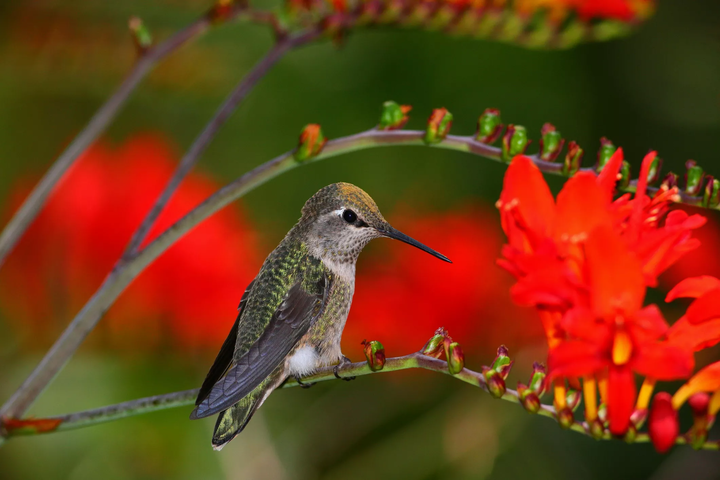Crocosmia bulbs are tall, summer-blooming plants that are just getting started when other spring bloomers like tulips are entering dormancy for the season. At first glance, the crocosmia flower seems to resemble the gladiolus, but this plant is actually a member of the iris family, which is fortunate as it's much hardier than annual glads in the garden. This showy plant attracts hummingbirds with its pigment-rich blooms and makes a gorgeous contribution to cut flower arrangements.
Botanical Name:
Crocosmia spp.
Common Name:
Coppertips, montbretia
Plant Type:
Perennial bulb
Mature Size:
Two to four feet
Sun Exposure:
Full sun to partial shade
Soil Type:
Average with good drainage
Soil pH:
Neutral; pH 6.5-7.5
Bloom Time:
Mid-summer
Flower Color:
Red, yellow, and orange
Hardiness Zones:
USDA growing zones 5 or 6 to 9
Native Area:
South Africa

How to Grow Crocosmia
Crocosmia is one of those bulbs you don't need to think about much after planting. In fact, some gardeners complain that it has invasive tendencies; this is most true in areas with cool summers and mild winters, which mirror the growing conditions in its native South Africa.
Plant crocosmia bulbs in groups of 12 or more when the weather warms in spring for greatest effect. Plant at least three inches deep, both to help the bulbs survive the winter, and to help plants maintain an upright habit. The long foliage stalks tend to lay down, something you can fix with grow-through stakes.
Light
Full sun is best for crocosmia plants. They will flop in shady growing conditions. Some afternoon shade is fine in hot areas. If your crocosmia plants are straining towards the sun, dig them up and relocate them.
Soil
Crocosmia plants don't need to be pampered when it comes to soil, but good drainage is important. If your soil is comprised of heavy clay, grow crocosmia plants in raised beds or containers.
Water
Crocosmia plants need regular watering, but you should not overwater them. Water when the top of the soil feels dry.
Temperature and Humidity
Although crocosmia tolerates high heat and humidity, it really takes off in drier climates with mild temperatures. Perhaps too much of a good thing isn't desirable, according to gardeners in places like Pacific Northwest where plants have a tendency to take over the flowerbed.
Fertilizer
Crocosmia grows well in lean or rocky soils and doesn't need supplemental fertilizer. Excessive nutrients can cause an overgrowth of foliage at the expense of the blooms.
Potting and Repotting
Any commercial potting soil will do for your crocosmia bulbs. Plant bulbs closely in the container, and watch for the grassy foliage to emerge a few weeks after a spring planting. If no blooms occur the first season, your bulbs may be too small to flower, and you can leave them growing in place until the next season.
Propagating Crocosmia
You can propagate crocosmia by removing the small offsets that form on the bulbs. This division process not only yields more flowers but also increases the overall vigor of the plants, as they can become crowded as do their cousins in the iris family. Dig the corms in the spring, and separate them by hand. Replant them six to eight inches apart.
Varieties of Crocosmia
Lucifer, a blood-red variety developed in 1966, is the most popular crocosmia variety in the trade.
Bressingham Beacon has bi-color orange and yellow flowers but isn't reliably hardy in zones five and six.

Toxicity of Crocosmia
Crocosmia should not be ingested and can cause mild gastrointestinal upset for pets. Keep bulbs out of reach of pets, as they may be consumed more readily than leaves.
Pruning
Crocosmia foliage does not need pruning. Leave the foliage in place after flowering so it can replenish the corms for next year's blooms.
Being Grown in Containers
Container culture is a great option for gardeners with compacted soil, or just for getting some color around the deck and patio. You can get away with a more dense planting in containers than in the ground; about five inches apart. Plant the bulbs three inches deep in any potting mix, and water thoroughly. Foliage won't emerge until temperatures warm.
Growing From Seeds
Collect seeds from capsules that form in the fall. Save seeds until spring, and then nick them and soak them to help speed germination. Plant in the ground in sandy loam after all chances of frost are past.
Common Pests and Diseases
Crocosmia is generally disease-free, except for cases where there is poor drainage that leads to root rot. However, spider mites can plague crocosmia plants, especially when dry conditions prevail. Mist plants daily to drive spider mites away.
Crocosmia vs. Gladiolus
Crocosmia and gladiolus plants have the same strappy foliage and summer-blooming time. Although gladiolus flowers come in a rainbow of flowers, they won't return as perennials the way crocosmia will. Because crocosmia and gladiolus enjoy the same sunny growing conditions, you can plant them as companions in the middle of the border or in containers.